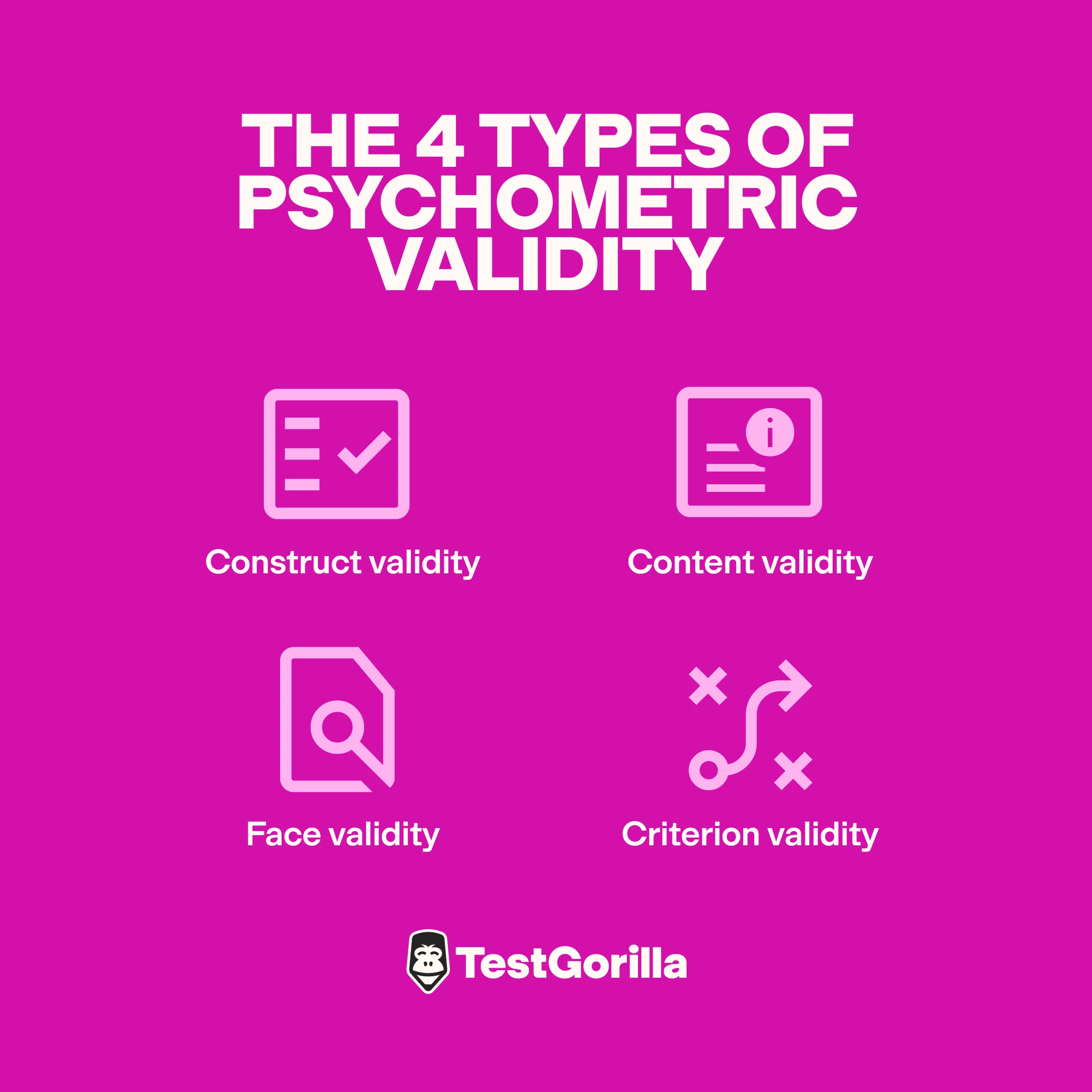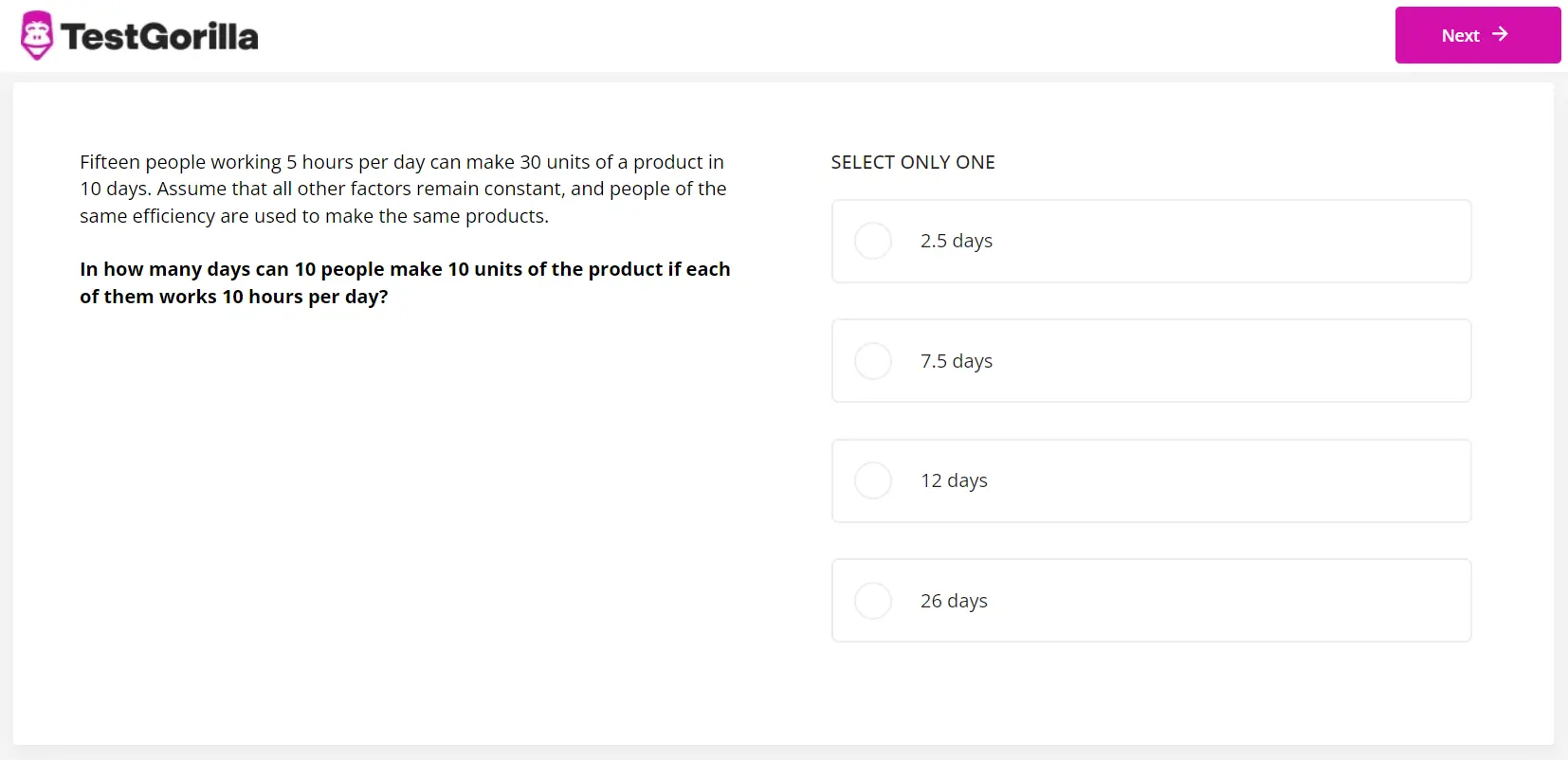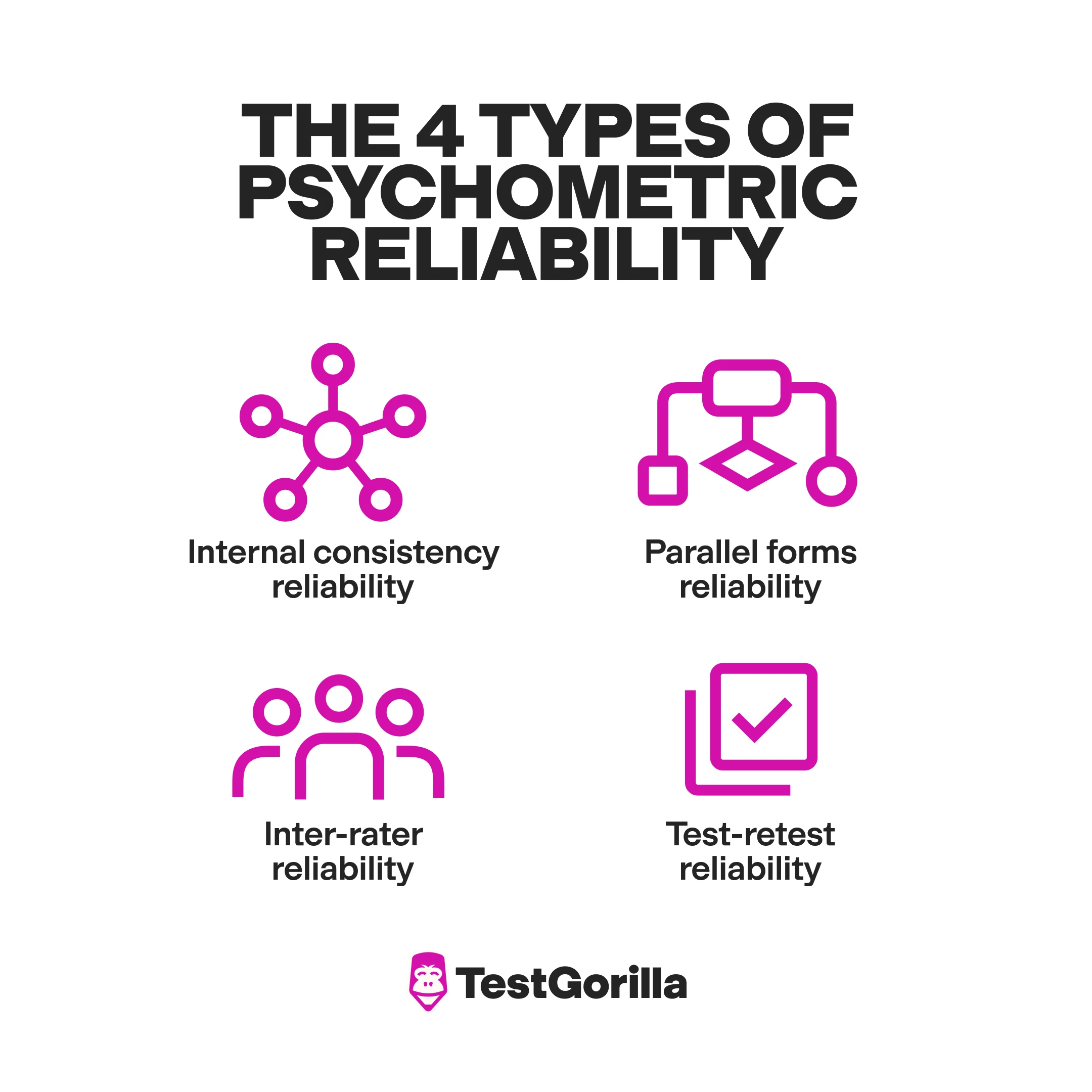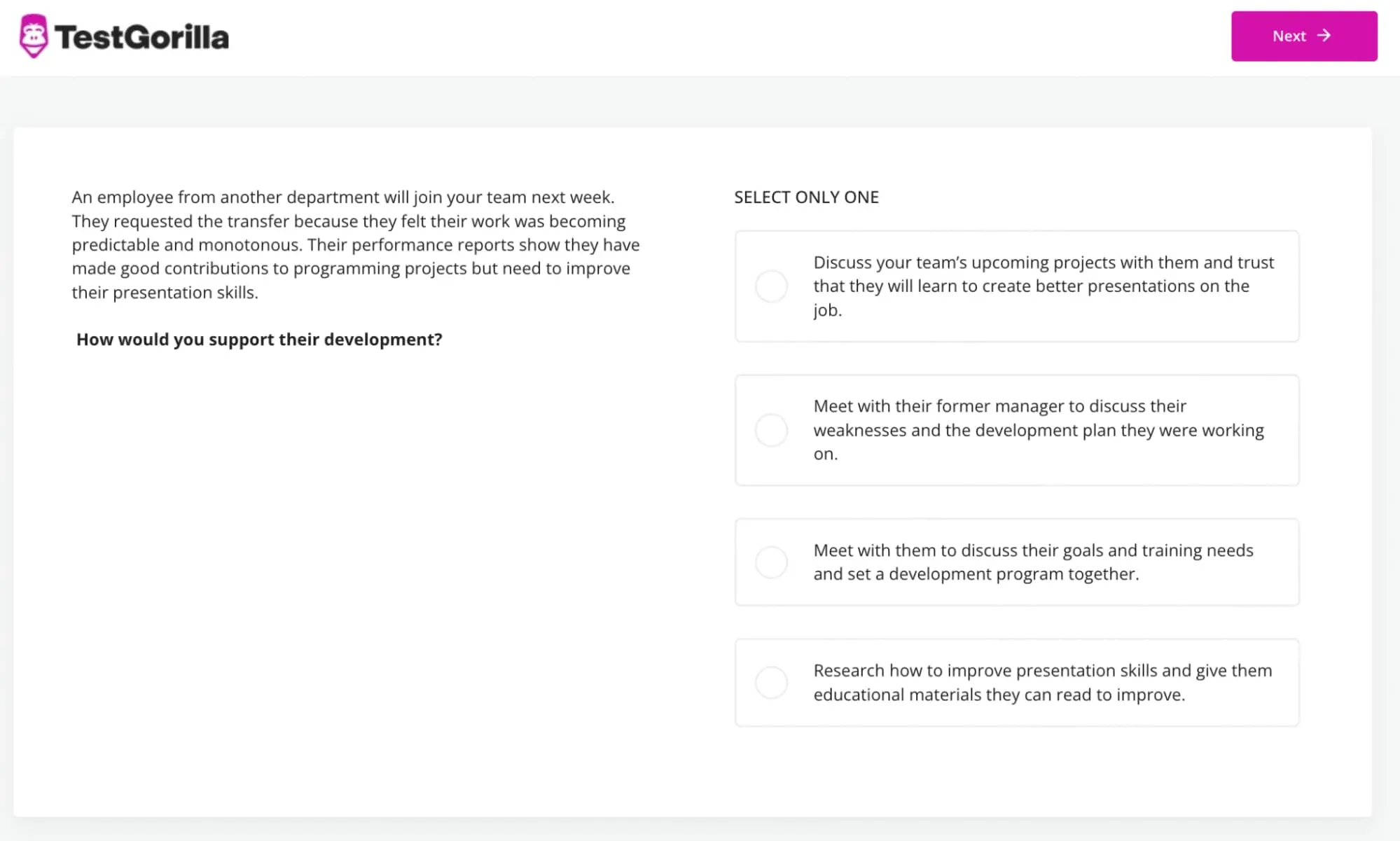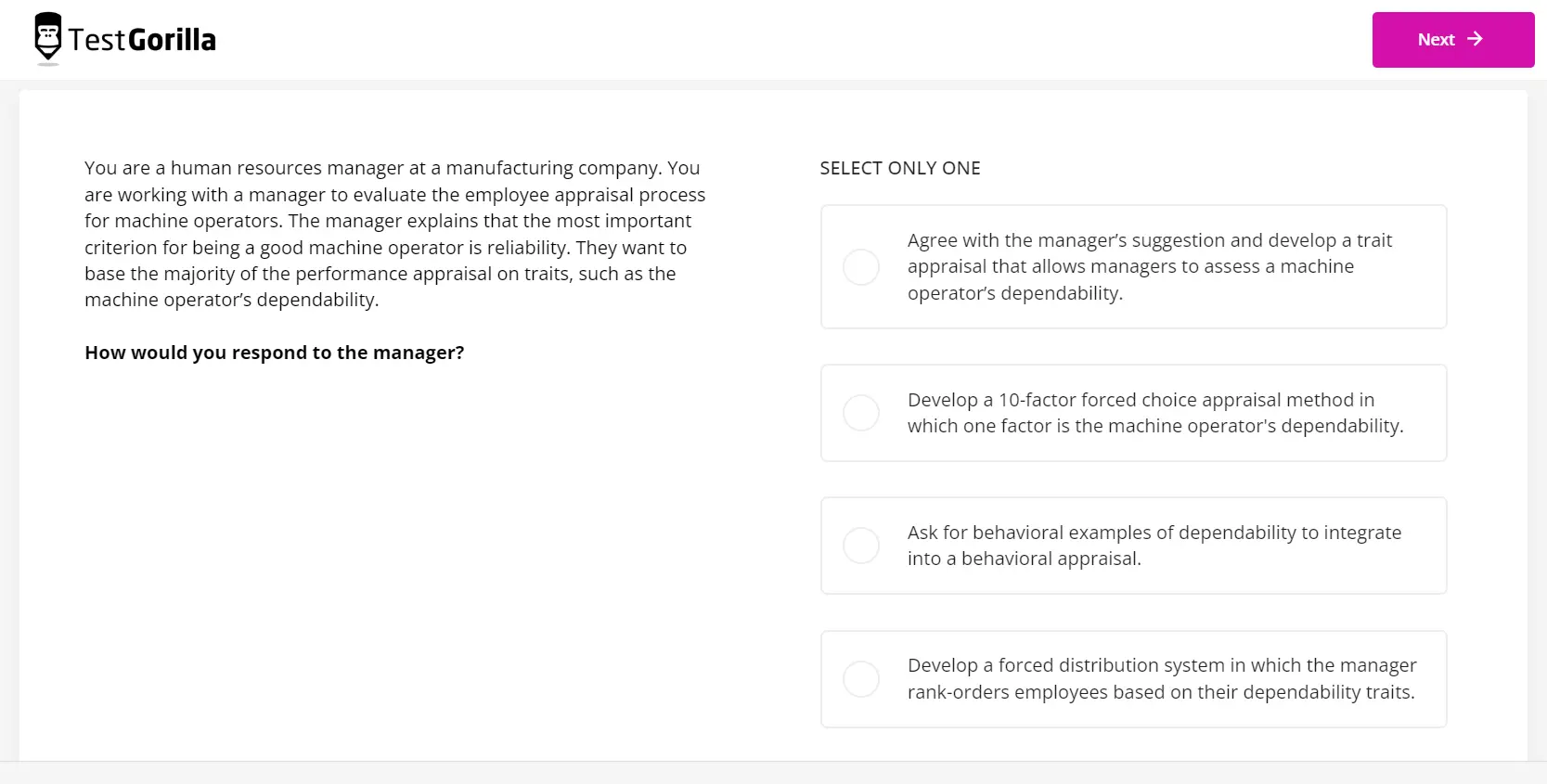What are the psychometric properties of talent assessments?
Pick proven talent assessments with the right psychometric properties
With good opportunities everywhere, in-demand candidates don’t want to wait to hear back. In fact, 62% of job seekers lose interest in a job if they don’t get a response from recruiters within two weeks, according to a Robert Half survey.
So, how do you hire faster without overlooking important details?
The solution is simple – ditch resumes and embrace talent assessments.
To do so, you need to find reliable tests with the right psychometric properties. This article examines the definition of psychometric properties, the importance of psychometric properties of standardized tests, and how to boost your hiring process in a way that’s anything but business as usual.
Table of contents
What are psychometric properties?
Psychometric properties are an assessment tool's technical qualities, such as validity, reliability, and norms. Validity confirms the test measures what it’s supposed to, while reliability indicates consistent results across time and contexts.
A test, questionnaire, or Likert scale with strong psychometric properties effectively measures cognitive abilities and disabilities, skills, or personality traits.
Simply put, different types of psychometric properties reveal information about the critical aspects of a test, such as:
Does the test work?
Does it produce accurate data?
Does it measure what it’s supposed to measure?
Can you trust the results?
Some psychometric properties of standardized tests use a numerical value, such as the reliability coefficient. Others, like psychometric validity, are too complex for a single quantifiable value, so they use a more descriptive analysis.
Psychometric properties are usually expressed quantitatively by a correlation coefficient or an index.
Understanding the importance of the psychometric properties of assessment tools is crucial because 56% of employers use pre-employment tests to evaluate candidates’ skills. So, no matter your industry, you need to know whether a skills assessment platform meets your needs to find the best candidates for a job.
What is psychometric validity?
Psychometric validity is the degree to which an assessment accurately measures the concept it claims to evaluate. High validity ensures that the test elements directly evaluate the specific attributes, skills, or constructs they aim to assess.
For example, TestGorilla’s Communication test measures a candidate’s ability to communicate effectively in a workplace. Its high psychometric validity means it genuinely assesses communication skills, not something unrelated like critical thinking.
You can use our assessments to test practical, in-the-trenches skills that make or break projects. In fact, that’s how Redfish managed to find better candidates.
This digital marketing agency needed help finding candidates whose real-life skills matched those on their resumes. It lacked a standardized way to assess the skills necessary for the job, which resulted in quite a few mis-hires.
Using our talent assessments with high psychometric properties validity, Redfish accurately screened and validated candidates’ skills before advancing them to the interview stage. This approach helped the agency focus on the right applicants and avoid costly hiring mistakes.
Now, why fuss over validity when you could just trust your gut?
In the high-stakes business world, hiring mistakes can cost you dearly – around $15,000 per mis-hire, to be more precise. A candidate can charm you in an interview, but you can't objectively measure their skills without a valid, scientifically-backed assessment.
Interested in trying talent assessments in your hiring process?
Then sign up for a free forever account!
The 4 types of psychometric validity
Evaluating the different types of psychometric properties validity is complex because it covers several aspects. Here are the four boxes a psychological assessment needs to tick:
Construct validity: How well does the test measure the construct it was created to measure? If the test claims to measure teamwork, this psychometric property ensures it assesses this trait and not something else, like leadership skills.
Content validity: Is the content appropriate, and does it evaluate all aspects of the particular construct it is measuring? It ensures the test isn’t leaving any critical areas unexamined, providing a full view of the candidate’s capabilities.
Face validity: Does the talent assessment appear to measure what it is intended to measure? It’s the initial “gut feeling” relevance that, while not the most scientific, still matters for overall quality because it impacts credibility and acceptance by stakeholders and test-takers.
Criterion validity: Do the assessment scores correspond to a benchmark test? This psychometric property confirms high test scores correlate with success in relevant tasks or roles.
Other types of validity you may find in a literature review like PubMed include:
Discriminant validity
Predictive validity
Concurrent validity
What is psychometric reliability?
Psychometric reliability is the consistency of a test’s results over time. It ensures that an assessment tool consistently measures the same attributes or abilities in the same way, regardless of when or how often you administer it.
This consistency offers a reliable way to evaluate skills and traits in various hiring cycles.
Reliability in psychometric assessments is all about equivalence and consistency – if you take a test multiple times or in different settings, you get similar results each time. It’s like a scale that gives you the same weight reading every morning.
By comparison, psychometric validity ensures the rating scale correctly calibrates to show your true weight.
A reliable test score stays consistent and accurate across multiple evaluations and after different raters grade the participants’ results. If a pre-employment test produces stable results over time, after repeated administration, or under similar circumstances, it is trustworthy and reliable.
Research supports talent assessments because companies that use them are 24% more likely to hire employees who exceed performance goals.
Ideally, you can evaluate a test’s psychometric reliability by administering the same assessment to the same participants at different times or presenting them with variations of the same test to see if their results are consistent.
However, in real life, this isn’t possible. You can still calibrate your test by administering it to existing employees before you use it on candidates.
For example, your finance department wants to use TestGorilla’s Numerical Reasoning test to hire analysts with consistent statistical analysis skills.
To check for reliability, you can administer this test to your employees and then retest the same group a few weeks later under similar conditions.
If the scores from both sessions are consistent across the board, it confirms the test’s psychometric reliability.
Keep in mind that minor discrepancies in this psychometric property can result from changes in the participants’ minds, feelings, current state, or circumstances. In addition, some people can respond with what they believe is the appropriate answer, even if it’s not authentic.
Some other issues that can negatively impact the reliability of a skill test are:
Difficulty or ambiguity of the questions
Unclear instructions or poorly defined administration
An uncomfortable environment with audio or visual distractions
The 4 types of psychometric reliability
There are four types of psychometric properties reliability for talent assessments:
Internal consistency reliability: Checks how well the different parts of the test work together to measure the same concept. If all test items correlate well, it indicates strong internal consistency, meaning the test fully measures a particular concept.
Parallel forms reliability: Confirms that different versions of a test that measure the same thing give similar results for the same group of people. It’s like two paths leading to the same destination – they should get you there with equal accuracy.
Inter-rater reliability: Focuses on the consistency of test scores when different raters evaluate the same test. High inter-rater reliability means that no matter who grades the test, the scores stay consistent, which is vital for fairness and objectivity.
Test-retest reliability: Evaluates the consistency of a person’s test results at two different points in time. Their scores should be similar on both occasions if the test is reliable. It’s like measuring your height at the start and end of a day – unless you’ve been stretching, those numbers should match up within a small standard error.
What are psychometric norms?
Psychometric norms are the average scores from a wide range of people. These benchmarks let us see how an individual compares with others, considering factors like age, education, or cultural background. That makes test scores easier to understand and compare.
This data provides more context that goes beyond mere right or wrong answers. It offers a more nuanced understanding of where someone stands on the spectrum of a particular ability.
For example, let’s consider the Leadership and People Management test. The psychometric norms for this test are calculated from a large, diverse group of leaders across various industries and nations.
See more example questions from this test.
When you want to hire a new manager, their test score shows you exactly how they compare with the industry standard. If they score in the 90th percentile, it means they performed better than 90% of the leaders, signaling exceptional leadership skills.
Considering that only 4% of all employees are high performers, you want to snatch up these skilled workers as quickly as possible.
How are reliable and valid talent assessments built?
Talent assessments are objective and standardized tools for gathering and evaluating data that can improve hiring. They aim to eliminate human bias from the screening process and provide you with the information for data-driven decision-making.
Talent assessments must have the right psychometric properties to transform your hiring into a precise, unbiased selection process, which is crucial for ensuring the reliability and validity of the data they provide.
Here’s what creating valid and reliable talent assessments looks like:
Defining objectives: The first step is to have a crystal-clear understanding of what the assessment should measure, like cognitive abilities, personality traits, or job-related skills.
Creating questions: Based on the defined objectives, test creators collaborate with subject matter experts to create challenging but fair questions free from cultural or linguistic biases.
Pilot testing: Before an assessment goes live, it undergoes psychometric testing with a sample group representing the target population to identify any issues with questions, such as lack of clarity or cultural insensitivity.
Analyzing test data: Experts analyze a test's validity, reliability, and other psychometric properties.
Establishing benchmarks: Test creators use a larger and more diverse sample to establish psychometric norms after a validation study. They provide a benchmark for interpreting individual scores, helping employers make meaningful comparisons between candidates.
Ongoing adjustments: Good talent assessments require systematic review and calibration to remain accurate and relevant over time. That includes updating questions, re-evaluating norms, and incorporating test feedback.
At TestGorilla, we are fully committed to this scientific, multilayered approach. Here’s what we do to ensure great psychometric properties of a test:
Build a framework: The psychometrics team follows well-established principles of test theory to construct the test’s framework.
Develop the questions: Subject-matter experts collaborate with our team to develop the questions for the test.
Peer review: Experts review the questions to ensure their accuracy.
Confirm consistency and fine-tune the test: We use advanced statistical algorithms, factor analysis, and intraclass correlation to track down and analyze key indicators in our tests so that we can improve them. Measures such as Cronbach’s alpha help us confirm the internal consistency of each assessment.
Verify the test’s validity: We use the Uniform Guidelines on Employee Selection Procedures framework of employee selection and the U.S. Department of Labor’s skills analyses to verify the test’s validity.
Collect feedback: Collecting feedback about the performance of each successful candidate gives us data-driven recommendations about which tests to use for particular job roles.
Unlock the power of valid and reliable skills testing with TestGorilla by signing up for a free account and reducing mis-hires!
We also work with subject-matter experts to create large question banks for each test and assign them to skill areas. Question banks contain hundreds of questions to guarantee that candidates don’t see the same questions even if they retake the test several times.
Here’s an example of a question you can encounter if you take our Performance Management test:
The algorithm that selects the questions for the pre-employment tests takes multiple factors into account:
The skill area of each test: Ensures that each area receives equal attention.
Whether a candidate has taken the same test before: Confirms that applicants receive different questions every time they take the test.
The maximum exposure count: To protect the test's integrity, each question has a limited lifetime. Once it has been used a certain number of times, it expires.
Finally, we’ve built our platform based on the Equal Employment Opportunity Commission standards to guarantee a fair, skills-based hiring process.
This means we use differential item functioning to support bias-free hiring. This statistical property shows how likely diverse groups of people with the same skills are to select different answers to the same questions.
Hire better talent with TestGorilla’s reliable talent assessments
Better, faster, more reliable, unbiased, and data-driven – this is what your hiring process looks like when you use valid, reliable talent assessments.
Our tests’ psychometric properties ensure they consistently measure what they are intended to and can provide a solid foundation for important hiring decisions.
Take a product tour to learn how our tests make your hiring process fairer and more objective.
You can also book a live demo to learn about all the benefits of our talent assessments and how to incorporate them into your hiring strategy.
However, the best approach is to sign up for a free forever plan and create an assessment using our free tests.
Psychometric properties of standardized tests FAQs
Do you still have questions about the importance of the psychometric properties of measurement instruments? Find your answers below.
What are the three psychometric properties?
Reliability, validity, and norms are the three main psychometric properties of assessment tools essential for evaluating their effectiveness. Reliability ensures consistent results over time, validity confirms the test measures what it’s intended to, and psychometric norms provide a benchmark to interpret and compare a score within a larger context.
These three psychometric properties of a test contribute to a fair and accurate assessment.
What are the psychometric properties of a good test?
The psychometric properties of a good test include validity, reliability, standardized administration methods, and norming. Validity verifies that the test evaluates the right skills, reliability guarantees consistent results, standardized administration provides uniform testing conditions, and norming offers a framework for easy result comparison.
These properties collectively ensure a test’s effectiveness, specificity, accuracy, and applicability in assessing specific attributes or skills.
What is an example of psychometrics?
An example of psychometric psychology is a personality assessment like the Myers-Briggs Type Indicator, which evaluates individuals based on preferences in how they perceive the world and make decisions. Its results don’t change based on the language, like English or Chinese, or the location in which it is administered – be it London or New York.
This test uses psychometric properties to categorize personalities into 16 distinct types, providing convergent insights into personal strengths, preferences, and compatibility with others in work and personal environments.
Note that, in healthcare settings, clinicians may also use self-reported psychometric metrics, like the Pearson Clinical Assessment, or another methodology for psychological testing. They typically use cognitive, language, and motor subscales for psychometric testing.
Related posts
Hire the best candidates with TestGorilla
Create pre-employment assessments in minutes to screen candidates, save time, and hire the best talent.
Latest posts
The best advice in pre-employment testing, in your inbox.
No spam. Unsubscribe at any time.

Hire the best. No bias. No stress.
Our screening tests identify the best candidates and make your hiring decisions faster, easier, and bias-free.
Free resources
This checklist covers key features you should look for when choosing a skills testing platform
This resource will help you develop an onboarding checklist for new hires.
How to assess your candidates' attention to detail.
Learn how to get human resources certified through HRCI or SHRM.
Learn how you can improve the level of talent at your company.
Learn how CapitalT reduced hiring bias with online skills assessments.
Learn how to make the resume process more efficient and more effective.
Improve your hiring strategy with these 7 critical recruitment metrics.
Learn how Sukhi decreased time spent reviewing resumes by 83%!
Hire more efficiently with these hacks that 99% of recruiters aren't using.
Make a business case for diversity and inclusion initiatives with this data.


